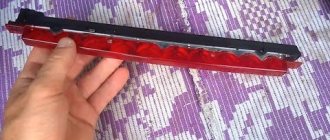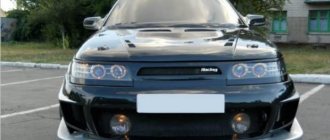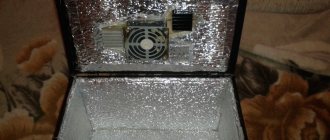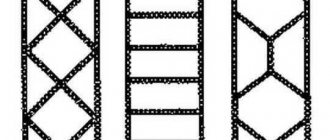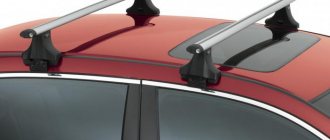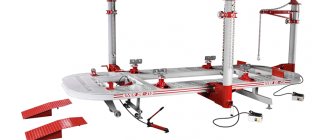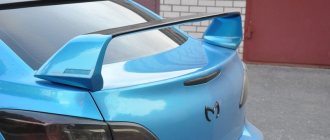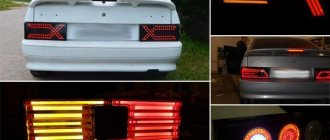Hello, dear car enthusiasts! We are considering a rather sensitive topic, to which many may react extremely ambiguously, in some places negatively. After all, we are talking about a flashing brake light.
Considering the capabilities of online stores, as well as the skills of some garage craftsmen, you can buy or assemble almost anything with your own hands.
But before you make your feet with a flashing effect, you should think about the feasibility and legality of such upgrades. Not everyone knows how traffic police officers will react to flashing lights.
What the laws and regulations say
The modified pattern, which turns a constantly lit brake light into a flashing one, raises many questions.
It would seem that if you can buy a ready-made controller from Aliexpress or order it from other stores, then there is nothing illegal about it. It’s even possible to hang a strobe light on a car. The only question is what consequences this will have.
The first thing you should do is look at the traffic rules. Oddly enough, not a word is said here about a ban on the use of such devices. After all, when the stops are blinking, the color of the flashlight itself does not change. Therefore, there is no corpus delicti as such. Everything is legal. But the light is blinking. And this is a reason to impose a ban.
Although the traffic rules do not say anything, there are also technical regulations. And here it is precisely stated that a flashing brake light is a prohibited type of tuning. Appendix 8 clearly states that no car lights, except turn signals and emergency lights, should blink.
Electrical circuit of a blinking brake light “option 2”.
This scheme implements the option of blinking during the first moments of the brake lights, and then the LEDs should shine evenly, without flickering. The circuit is based on 2 timers based on NE 555 microcircuits. First, the generated control signal is discretely supplied to the transistor in the same way as the first circuit, and then a constant voltage is generated on its basis. Eventually the relay stops working and becomes a conductor.
Possible punishment
There is nothing in the traffic rules, but there is something in the technical regulations. Hence the logical question about whether they can be punished for flashing lights, and what the possible fine is in such a situation.
Here, traffic police officers will build on Article 12.5 of the current Administrative Code. The emphasis is on the fact that a flashing stop indicates an incorrect operating mode of the equipment. As a result, a fine of 500 rubles. But in addition, the driver may also suffer for making changes to the design of his vehicle.
A non-standard lamp is a malfunction
The flicker mode is certified in Russia and is built into the electrical control unit of modern cars. It is designed for the rear lights of cars and is used to indicate the emergency braking process. If the car's ABS is activated and it slows down to the limit of wheel traction, the electronics prepare all systems for a possible collision. The power windows are closed, the seat belt is tightened, and the rear lights are activated to warn drivers of passing cars about the risk of an accident. Either the brake lights or the yellow hazard warning lights are flashing. In this case, the flow of traffic should also slow down.
However, flickering red lights installed for the sake of beauty mislead others and actually work in uncertified modes. In accordance with technical regulations and traffic rules, this can be considered a malfunction in which operation of the vehicle is prohibited.
Several articles of the Traffic Regulations are devoted to lighting devices and vehicle lighting equipment. In paragraph 3.3. The list of faults states that the car cannot be operated if “the external lighting devices and reflectors are not working in the prescribed mode or are dirty.” Clause 3.1. The list of traffic rules faults is even more categorical. According to it, “the number, type, color, location and mode of operation of external lighting devices must comply with the design requirements of the vehicle.”
Gas or LEDs? What are matrix headlights and why are they better than xenon ones? Read more
To bet or not
This is a personal matter for everyone.
And you have your own opinion on this matter. Some are sure that flashing stop signs distract attention and cause a feeling of confusion among drivers moving behind such cars. After all, the intentions of the motorist are not always clear.
It also happens that, due to the flickering, the motorist behind does not have time to brake in time, because he glances at the feet exactly at the moment when the lamp goes out.
There is also the opposite opinion, according to which flickering makes you be more attentive and vigilant. Fans of this theory cite design solutions on Formula 1 cars as an example. After all, their feet also blink during active or sudden braking.
You decide. But remember that such changes can easily be classified as illegal. As a result, the driver faces a fine. And not only the modest 500 rubles. For illegal design changes, sanctions can be much more serious.
Here it would not be amiss to remember why the brake lights do not light up and what this may be connected with.
What to pay attention to
The brake light in the bumper must perform its function as correctly as a regular VAZ-2114 brake light. This kind of tuning can attract attention with its unusual animation. Drivers and other road users may pay more attention to this animation than to the actions of the driver himself in terms of actual braking on the highway. Therefore, not everyone has time to immediately assess the situation and may confuse turning with braking. In this case, a traffic accident may occur.
When you press the brake pedal, all the brake light bulbs should light up at the same time in order to attract the attention of the driver behind as much as possible, and only then you can turn on the necessary animation for visual display. Basically, for drivers, the brake light performs a completely different function.
If the driver makes a turn, he must first slow down before turning in the direction he wants, after which the brake light comes on. For safety, it is recommended to turn on 2 animations at once for at least 2 seconds, so that other drivers understand that the car will first slow down and only then turn. Many people act differently: first they turn on the turn signal, then they brake, so it is not always clear that the driver will brake or turn, because the flashing turn signal is difficult to see on the LEDs, although it is on.
Running turn lights can look more impressive if the animation speeds up towards the end of its action. This gives great elegance to the spoiler, but also adds attention to other road users. With such turn signals, it is clear that the driver is already turning in the right direction and has already finished braking.
As a rule, all these subtleties decorate a car on the road, but many drivers believe that these “things” are a threat to traffic and can lead to a traffic accident.
Do it yourself
See also
Automotive impact wrench: which one is better to choose
Experience shows that a flashing brake light is most often the prerogative of domestic cars that are actively used for tuning. These are cars such as VAZ 2110, Lada Kalina, Lada Priora, etc.
But it’s quite difficult to imagine the owner of a new foreign car with such tuning. Although situations are different.
There are several options for how to implement flashing stops on a car. Let's look at 2 of them.
With relay
The easiest way to implement the idea of flashing brake lights is to use a turn signal relay.
Only here it is worth immediately emphasizing that such a scheme is not always characterized by increased reliability. A scenario in which the relay fails cannot be ruled out. This largely depends on the build quality. Therefore, motorists are advised to initially choose high-quality relays. And the best option would be a rotary relay from the car on which the tuning is performed.
Now to the question of how to properly connect the relay. This is done through standard wiring. You just need to connect the rotary relay to the stop. Before insulation and assembly, it is recommended to check the system for functionality.
The main disadvantage of this method is that the stop light will flash continuously.
It is because of this that alternative schemes have gained the most popularity.
Using a microcircuit
There are various microcircuits. Among those in demand for the implementation of a flashing stop is a circuit of the K561TL1 type.
On its basis, a foot control unit is created. If everything is done correctly, the work scheme can be implemented to your taste and your own needs. To change the number of blinks, simply change the capacitance of capacitor C1, which is part of the microcircuit. The resistor resistance parameters also change.
Circuit C2-R2 in the microcircuit will be responsible for the frequency of flashes that occur. To avoid problems on the road, experienced craftsmen advise adding an instant shutdown button here. So the traffic police officers simply won’t see your flashing light, and therefore won’t be able to punish you for such tuning.
You can implement quick shutdown in 2 ways:
- Install a special button with a resistor directly in the cabin. The parameters of the latter should be 1 kOhm. By pressing this button, current will be supplied bypassing the microcircuit used, and then the feet will be able to function in standard mode;
- Use a regular switch. This way the brake light can switch and switch to normal power. This scheme is considered simpler.
Which one is more suitable for you, decide for yourself.
Circuit elements - DIY replacement options for a flashing brake light
Microcircuit - let's first consider its analogues. The easiest way is to get the American version CD4011A “Texas instruments”. It will be quite difficult to find a chip made in the USA, but there are plenty of Chinese options on the market.
Capacitor C1 has the following parameters: current is alternating, voltage above 16 V. Resistors must cope with a power of at least 0.25 W. You can install any LEDs that meet the voltage requirement above 3.3 V. Color is also an important indicator - brake lights should be red.
A universal circuit board will do an excellent job as the basis of our circuit; you just need to organize the connection of the elements with flexible conductors, which in itself is the simplest way to implement it. Also, no configuration or adjustment is required; it is only important to assemble everything correctly and preferably test it before putting it into operation.
The only drawback is the absence of any control based on the blinking principle. This circuit ensures that the brake light blinks from the moment you press the brake until it is completely released. It is logical to assume that it would be worth blinking for 3-4 seconds after pressing, and then shining constantly. In the following diagram we will look at the implementation of just such an option.
How the Rules are interpreted
In this matter, two provisions from the traffic rules are important to us:
- They precisely establish that the factory quantity, location, type and mode of operation of light signals cannot be changed. This is stated in paragraph 3.1 of the Rules.
- In addition, this regulatory act prohibits changing the design of the car without the consent of the traffic police, as stated in paragraph 7.18 of the traffic rules.
But how to understand lighting devices, do they include brake lights, how to understand the operating mode and location of the lights? Let's clarify this in relation to certain installation points.
Dynamic motorcycle brake lights
Developers and designers of modern motorcycle models pay great attention to increasing the visibility of two-wheeled vehicles on the roads. One of the new products offered for the first time by BMW is the dynamic brake light.
It has several operating modes, depending on the intensity of the braking process:
- When the speed decreases to 50 km/h, the brake light begins to blink at a frequency of 5 Hz.
- When the vehicle slows down to 14 km/h, the hazard warning lights turn on (it blinks until the motorcycle comes to a complete stop or until the speed reaches 20 km/h).
This is interesting: How to do tinting yourself (video instructions)
Starting from 2021, only top versions of BMW motorcycles are equipped with these devices. For motorcyclists with less prestigious models, such devices are offered as an additional option.
